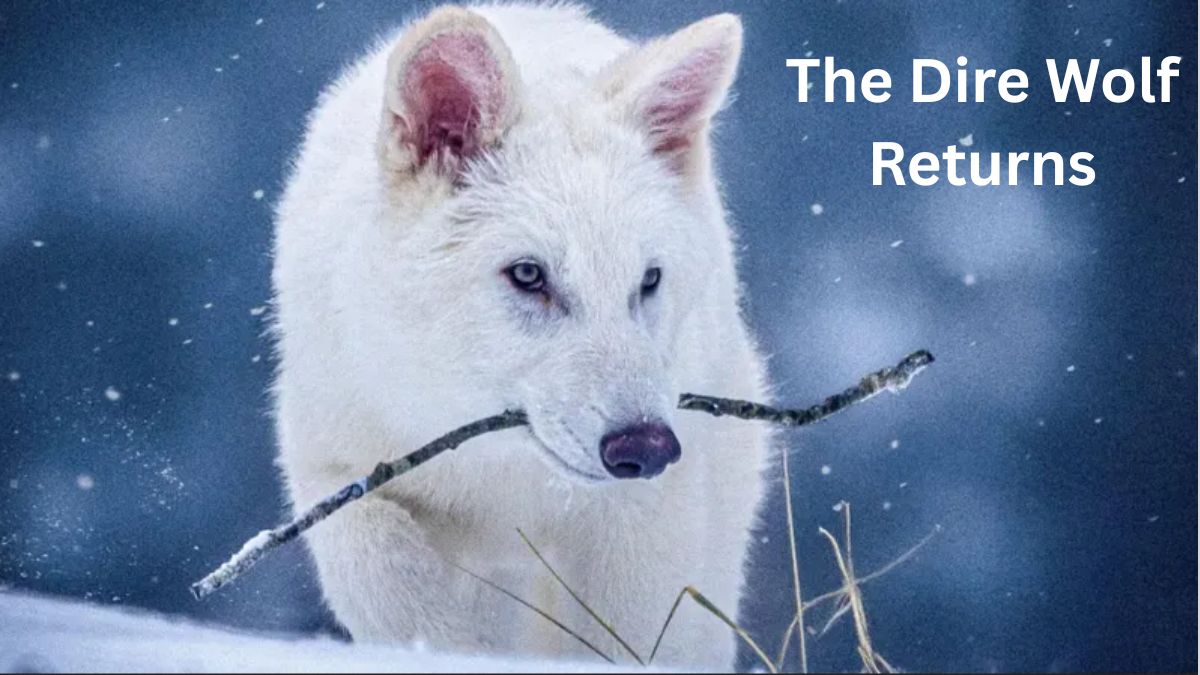The world was captivated when Time Magazine featured a striking snow-white wolf on its cover with the bold headline: “The Dire Wolf Returns.” Behind the headline is a bold claim from Colossal Biosciences, a company known for its ambitious attempts to bring extinct species back to life using advanced genetic engineering. The announcement focused on the birth of three genetically modified wolf pups—Romulus, Remus, and Khaleesi—touted as “de-extincted” dire wolves. But according to leading scientists, this declaration may be more fiction than fact.

Understanding the Dire Wolf
The dire wolf (Aenocyon dirus) once roamed the Americas over 10,000 years ago. It gained widespread fame through popular media like Game of Thrones, but in reality, it was a formidable predator of the Ice Age, larger and more robust than today’s grey wolves. Fossils show that it had stronger jaws and a broader skull, adapted for hunting large prey.
Unlike their fictional counterparts, dire wolves were a unique species—not just an oversized grey wolf. They are believed to have diverged from modern canines millions of years ago, placing them in a separate genus altogether.
What Did Colossal Biosciences Actually Do?
Colossal Biosciences claimed they used ancient DNA and sophisticated gene-editing tools to recreate the dire wolf. However, independent experts argue that what was achieved is not a true resurrection of the extinct species.
Key Methods Used:
-
Synthetic Biology: The team edited specific DNA sequences in grey wolf embryos.
-
Gene Cloning: Modified cells were cloned to form embryos.
-
Surrogacy: The embryos were implanted into domestic dogs and delivered via caesarean section.
These steps resulted in the birth of three pups who exhibit some physical traits associated with dire wolves—such as larger skulls and white fur—but are genetically modified grey wolves, not true dire wolves.
Expert Criticism: Why the Pups Aren’t Truly Dire Wolves
Dr. Nic Rawlence, a paleogeneticist at the University of Otago, explains that ancient DNA degrades significantly over time. “It’s like baking DNA in a 500-degree oven overnight,” he said. What remains is too fragmented to reconstruct a full, viable genome.
Rather than restoring an extinct genome, Colossal inserted select dire wolf-like traits into a living species’ DNA—in this case, the grey wolf. According to Rawlence, this results in a hybrid, not a resurrected species.
Furthermore, zoologist Philip Seddon clarifies that the dire wolf and grey wolf are not closely related as many assume. Despite superficial similarities, genetic research shows they diverged between 2.5 and 6 million years ago and belong to completely different genera.
The Ethical and Scientific Debate
This isn’t just a technical issue—there are deeper ethical and scientific implications. Dr. Rawlence warns that redefining extinction could mislead the public. “If we suggest we can just bring back lost species, are we also suggesting it’s okay to destroy ecosystems?”
Colossal Biosciences has also expressed interest in reviving other extinct animals like the woolly mammoth and Tasmanian tiger. While such projects are intriguing, critics argue they may divert attention and resources from conservation efforts aimed at preserving endangered species that still exist.
Where Are the “Dire Wolves” Now?
The three genetically edited wolf pups are currently housed on a 2,000-acre private facility in the northern United States. While their appearance may evoke the dire wolves of legend, their genetic blueprint is far from an accurate replica. Still, the achievement marks a milestone in synthetic biology—albeit one that’s stirring up considerable debate.
Dire Wolf vs. Genetically Modified Grey Wolf
| Feature | Dire Wolf (Extinct) | Genetically Modified Grey Wolf |
|---|---|---|
| Genus | Aenocyon | Canis |
| Time Period | 10,000+ years ago | Present |
| Skull and Size | Broad skull, large size | Enlarged skull (via genetic editing) |
| DNA Source | Fossilized remains (degraded) | Modern grey wolf DNA |
| Actual Genome Match | Not possible | Partial trait-based match |
| Surrogacy Method | Not applicable | Domestic dog via C-section |
| Status | Extinct | Genetically engineered hybrid |
FAQs
Q1: Are Romulus, Remus, and Khaleesi real dire wolves?
No. They are genetically modified grey wolves with some dire wolf-like traits. Experts agree they do not represent a true de-extinction of the species.
Q2: Why can’t ancient DNA be fully used to recreate extinct animals?
Ancient DNA is highly degraded and fragmented. While some sequences can be reconstructed, they’re insufficient for cloning or complete genome creation.
Q3: What’s the difference between a hybrid and a resurrected species?
A hybrid contains selected traits from one species introduced into another, while a resurrected species would require a near-complete and functional genome of the original organism.
Q4: Could this technology help endangered species?
Yes, gene editing could potentially aid conservation by bolstering genetic diversity in endangered populations, though ethical concerns remain.
Q5: What’s next for Colossal Biosciences?
The company aims to apply similar genetic methods to revive other extinct species, including the woolly mammoth and Tasmanian tiger, sparking ongoing debate in the scientific community.
Click here to know more.